
The Schenk Graf von Stauffenberg family is a noble (Uradel) Roman Catholic family from Swabia in Germany. The family's best-known recent member was Colonel Claus Schenk Graf von Stauffenberg – the key figure in the 1944 "20 July plot" to assassinate Adolf Hitler.

The House of Schönborn[ˈʃøːnbɔrn] is the name of an ancient noble and mediatised formerly sovereign family of the former Holy Roman Empire.
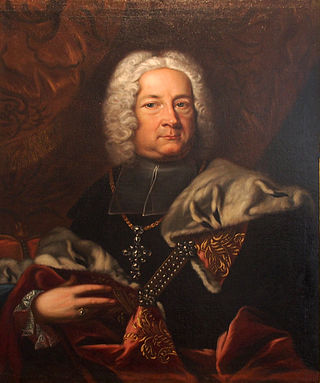
Friedrich Karl von Schönborn was the Prince-Bishop of Würzburg and Prince-Bishop of Bamberg from 1729 to 1746. He also served as Reichsvizekanzler (Vice-Chancellor) of the Holy Roman Empire from 1705 to 1734.

The House of Liechtenstein, from which the principality takes its name, is the family which reigns by hereditary right over the principality of Liechtenstein. Only dynastic members of the family are eligible to inherit the throne. The dynasty's membership, rights and responsibilities are defined by a law of the family, which is enforced by the reigning prince and may be altered by vote among the family's dynasts, but which may not be altered by the Government or Parliament of Liechtenstein.

The Military Order of Maria Theresa was the highest military honour of the Habsburg monarchy, Austrian Empire and Austro-Hungarian Empire.
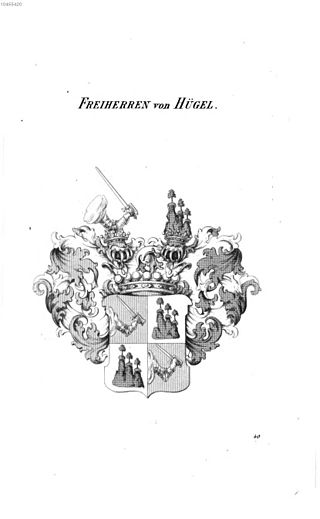
The House of Hügel is a German noble family originating from Württemberg. In 1801 the family was raised to the hereditary rank of Imperial Baron by Francis II, Holy Roman Emperor, while on 13 June 1879 the family was raised to the hereditary title of Count in the Kingdom of Württemberg by King Charles I.
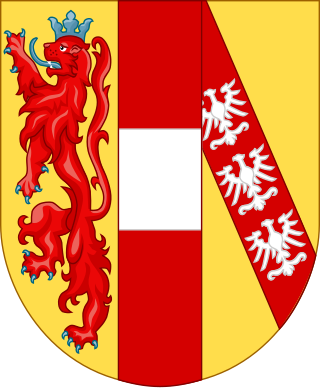
The House of Habsburg-Lorraine originated from the marriage in 1736 of Francis III, Duke of Lorraine and Bar, and Maria Theresa of Austria, later successively Queen of Bohemia, Queen of Hungary, Queen of Croatia and Archduchess of Austria. Its members are the legitimate surviving line of both the House of Habsburg and the House of Lorraine and inherit their patrimonial possessions and vocation to the Empire from their female line of the House of Habsburg and from the male line of the House of Lorraine.

The House of Starhemberg is the name of an old and distinguished Austrian noble family originating from Upper Austria, specifically Steyr and Steinbach. Members of the family played important political role within the Holy Roman Empire and later in the Austro-Hungarian Empire.

Prince-provost is a rare title for a monastic superior with the ecclesiastical style of provost who is also a Prince of the Holy Roman Empire (Reichsfürst), holding a direct vote in the Imperial Diet assembly coequal to an actual Prince-abbot, as in each case treated below.

Archduke Franz Salvator of Austria was the son of Archduke Karl Salvator of Austria and Princess Maria Immacolata of Bourbon-Two Sicilies. He married Archduchess Marie Valerie in 1890, though, due to Marie Valerie's death in 1924, remarried in 1934 to Baroness Melanie von Riesenfels.
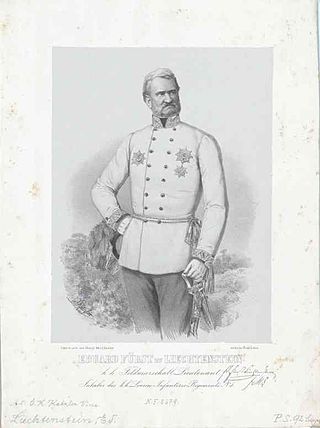
Prince Eduard Franz of Liechtenstein was a son of Johann I Joseph, Prince of Liechtenstein (1760–1836) and wife Landgravine Josepha of Fürstenberg-Weitra, nephew of Aloys I, brother of Aloys II and uncle of Johann II and Franz I.

Tratzberg Castle is a castle in Jenbach, Tyrol, Austria. Tratzberg Castle is located on a steep ridge above Jenbach in the Austrian part of Tyrol. It is an excellent example of palace architecture typical for the alpine parts of the Holy Roman Empire during the late Gothic and early Renaissance period. The castle was built in its present form in 1500 mostly by the brothers Veit-Jakob and Simon Tänzl. Today Tratzberg Castle is owned and inhabited by Count Ulrich Goëss-Enzenberg and his wife Katrin Goëss-Enzenberg. Tratzberg is also one of the best preserved castles in Austria, having many of its original furnishings and fittings.

The House of Waldburg is a princely family of Upper Swabia, founded some time previous to the 12th century; some cadet lineages are comital families.

The House of Khevenhüller is the name of an old and important Carinthian noble family, documented there since 1356, with its ancestral seat at Landskron Castle. In the 16th century, the family split into the two branches of Khevenhüller-Frankenburg, Imperial Counts from 1593, and Khevenhüller-Hochosterwitz, raised to Imperial Counts in 1725 and, as Khevenhüller-Metsch, to princely rank (Fürsten) in 1763. The family belongs to high nobility.

Archduke Maximilian of Austria was a member of the House of Habsburg-Lorraine and the younger brother of the Emperor Charles I of Austria.

Maximilian, Duke von Hohenberg, was the elder son of Archduke Franz Ferdinand of Austria-Hungary and his wife Countess Sophie Chotek von Chotkowa und Wognin, Duchess von Hohenberg. Because his parents' marriage was morganatic, he was excluded from succession to the Austro-Hungarian throne, to which his father was heir presumptive, and to inheritance of any of his father's dynastic titles, income, and properties, although not from the archduke's personal estate nor from his mother's property.
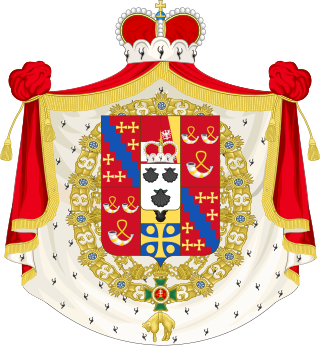
The House of Metternich was an old German noble family originating in the Rhineland. The most prominent member was Prince Klemens von Metternich, who was the dominant figure at the Congress of Vienna (1814–1815). As a former reigning house (mediatised), the Metternich family belonged to the small circle of high nobility.
Events in the year 1886 in Germany.

Schottengymnasium is an independent Catholic gymnasium with public status in the First District of Vienna. The school was founded in 1807 by imperial decree, and is considered one of the most prestigious schools in Austria. Alumni of the school include three Nobel laureates, several notable politicians, monarchs, artists and scientists.

Count Erwin Franz Ludwig Bernhard Ernst von Neipperg was an Austrian General of the Cavalry of Württembergian descent who was notable for being the main commander at the Battle of Aschaffenburg.



















